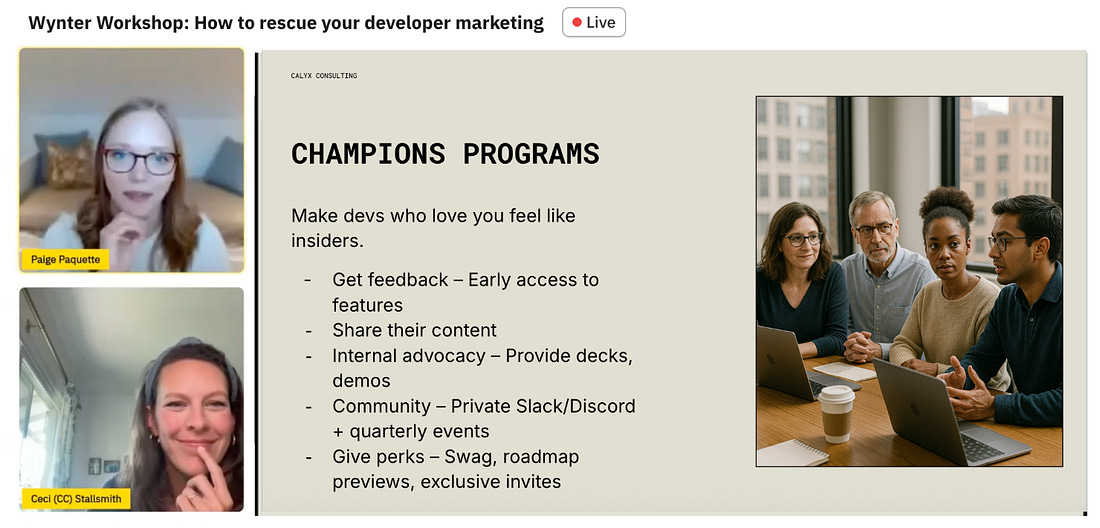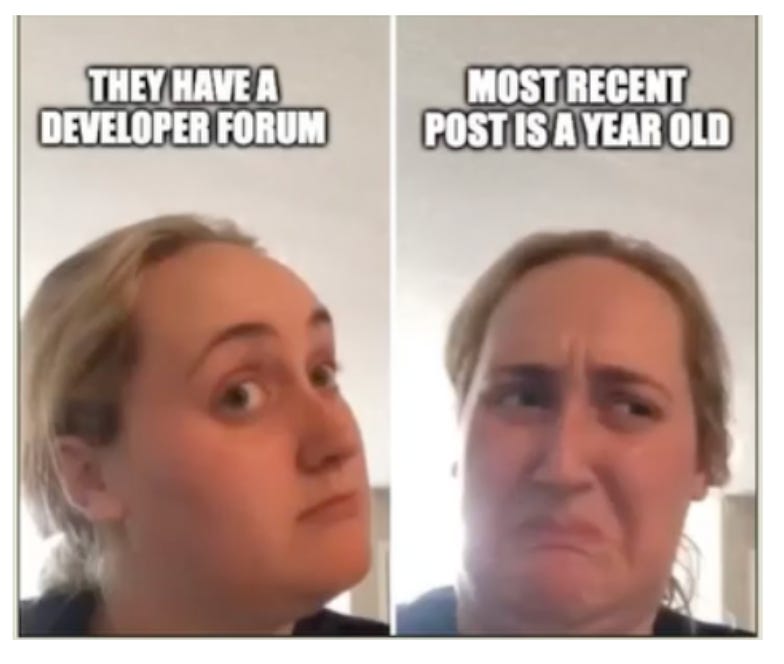Developer Marketing in 2025: What Works, What's Changing, and How to Win
- Carilu Dietrich from Hypergrowth Leadership <carilu@substack.com>
- Hidden Recipient <hidden@emailshot.io>
Developer Marketing in 2025: What Works, What's Changing, and How to WinInsights from inside Stripe, Twitter, Slack, HubSpot and 1PasswordAs someone who led developer marketing initiatives at Atlassian, I've seen firsthand how this specialized form of marketing has evolved. Even though I'm deeply immersed, I'm always hungry for fresh insights. So I was excited last week to watch a webinar by two heavyweights: Cecilia Stallsmith and Paige Paquette. These two were developer marketers and evangelists at Slack and Box, and now run a vibrant consulting practice, Calyx, where they’ve informed developer marketing programs for Stripe, Twitter, Slack, HubSpot, and more. I worked with them on a big developer launch at 1Password and was deeply impressed by their velocity and work. Their insights, combined with my own experiences, have crystallized what's working now and what's changing in 2025. What's Changing in Developer MarketingThe Expanding "Developer" AudienceOne of the most striking shifts of 2025 is how dramatically the definition of "developer" is expanding. Today's developer tools are remarkably easy to use, creating slick experiences that developers not only use but expect. And, AI is empowering a much wider group of people to build technical flows and software without deep developer expertise: vibe coding. This accessibility has broadened what we consider "technical" work:
This democratization means that developer marketing strategies are becoming applicable to a much wider audience than ever before. The Core Elements of Successful Dev MarketingExceptional Product Experience is a MustThe foundation of successful developer marketing remains unchanged: your product must deliver exceptional value. Atlassian spent double what most of its competitors of its size did on Product & Engineering to make the most delightful, helpful software for developers we could (we took that money from sales in the original PLG model). Your product experience must be exceptional for a developer to use and champion it. This includes:
Ceci added in the webinar that, as simple as it sounds, keyboard shortcuts are still wildly popular with developers. And, regularly fixing pain points is a must. Ceci told a story of how Stripe famously fixed the top 100 onboarding "paper cuts" and saw growth accelerate significantly. Technical Value Above AllDevelopers are fundamentally different from other audiences. They actively distrust traditional advertising and marketing fluff. They use tools to block most ads, and distrust most of what vendors say about themselves, preferring online communities and recommendations from developers they respect. Your best approach is to demonstrate value rather than claim it, which is why content that shows real implementation and allows hands-on testing consistently outperforms traditional marketing. This hasn’t changed. What developers actually want:
This is precisely why Product-Led Growth works so effectively for developer tools. It puts the product experience front and center, allowing developers to judge for themselves rather than relying on marketing claims. They want to see, touch, and experiment with your product before making any commitment. Ceci and Paige reinforced that developers have zero tolerance for high-level, generic content. Your content strategy must be:
Last year I wrote about an innovative approach dev-loved Vercel used - replacing business development reps with product advocates. Instead of starting a sales pitch to qualify leads, these people, developers themselves, provided resources, answered questions, and technically engaged prospects. It was fantastically successful. Product and Power Users: Your FoundationIf the product is awesome, you can move on to nurturing power users, which is the flywheel of word-of-mouth marketing. Ceci and Paige shared insights into how Slack founder Stewart Butterfield famously gave early beta versions of Slack to top engineering leaders across Silicon Valley, garnering early feedback and securing influential advocates who later shared Slack with their teams, colleagues, and influential friends. Over the years, Slack reinforced this strategy by giving developer champions insider access to betas, roadmaps, and executives through quarterly advisor board meetings. These strategies are still central to successful developer marketing today - deeply engaging influential people within top companies and top communities with special access, camaraderie, and helpful support that are valuable to them. Word-of-Mouth Love Builds BrandWinning over these power users and having them drive word-of-mouth marketing can pay huge dividends. Ceci emphasized that developers can be very passionate and loyal once they love a product: "The tools developers choose and use become part of their identity." From my time at Atlassian, I saw the same thing. Your product isn't just a tool; it's an extension of who they are as professionals. Developers will passionately defend their favorite products if they serve them well. They often list their languages, tools, and projects on their resumes, building a career around their allegiance. If you are their tool of choice, their love can drive your sales. On the webinar, CeCi and Paige mentioned, “No one looks ‘lame’ using Cursor right now. No one gets in trouble for setting up Stripe.” In the current world of rapidly changing AI models and a noisy market of vibe coding and new developer tools, it will be interesting to see who gets long-term allegiance and which products come quickly in and out of fashion. Make Your CEO a “Spiritual Leader”One thing that continues to evolve in the new world order is the ascendancy of social media driving CEOs’ visibility. CEOs have always been expected to be the central spokesperson for the company, but always-on social media has given a massive distribution and engagement channel to visionary, entertaining, and intriguing CEOs who are willing to be active. The greatest example at the moment is Sam Altman, who individually has 3.6 million followers on X - more than every single executive at Anthropic combined. People follow OpenAI as well, but Sam’s personal social posts get deep engagement and show more personality. Altman is even active “in the trenches” on ProductHunt, where he has nearly 55,000 followers and posted just this week about AI coding updates. In this model, viral CEO are more than executives—they are almost spiritual leaders - not just promoting products, but championing philosophies about development, technology, and the future. They share a compelling point of view with a strong edge. They must be careful not to overstep - less they trigger developer ‘bullshit meter’ and backlash. But those that do it well are marketing machines. (Ceci and Paige also highlighted Amjad Masad, the CEO of Replit for his momentum and success in this category.) Community Building: Invaluable, but Proceed with CautionCommunities are incredibly powerful and remain a primary place where developers get their news and share their opinions. Which channels work now?
You can also build your own community in Discord, your site, or elsewhere — but be warned… a half-hearted community is worse than no community at all. If your community only contains unanswered support questions or shows inactivity for months, it damages your brand. Surprise and DelightThis blog is already too long, but I can’t leave without including the directive to add fun to your developer marketing to more deeply build a bond and affinity. Developers love finding hidden “Easter Eggs” - unexpected surprises, small insider jokes, funny memes, or emojis. And t-shirts. Developers love t-shirts. Atlassian’s original brand values were “Bold. Optimistic. Practical, with a Wink.” The wink was our nod to funny things that would appear in small but meaningful amounts across a prospect and customer’s experience. One of Slack’s killer features was custom emojis, where people could add their own form of humor to their communications. If I had more time this morning, I’d go hunting for lots of examples. Perhaps that’s a post of its own! Implementing These Insights: A Framework for SuccessBased on both the presentation and my Atlassian experience, here's a framework for implementing effective developer marketing in 2025:
Final ThoughtsAs the developer landscape continues to expand and distribution channels ebb and flow, the core principles persevere: provide exceptional technical value and technical insights from bright and interesting people. The most successful developer marketing doesn't feel like marketing at all. It feels like community, education, and shared vision. Master this approach, and you'll find developers not just using your product but championing it as part of who they are. Want more?Ceci and Paige went into even more depth in their webinar last week
They also have helpful developer marketing insights on Substack, and are worth a follow on LinkedIn: Cecilia Stallsmith and Paige Paquette. (I receive no benefit for this recommendation, I just follow them too) What developer marketing strategies have you found most effective? I'd love to hear your experiences in the comments below. Especially if you have examples of great developer humor! Carilu Dietrich is a former CMO, most notably the head of marketing who took Atlassian public. She currently advises CEOs and CMOs of high-growth tech companies. Carilu helps leaders operationalize the chaos of scale, see around corners, and improve marketing and company performance. You're currently a free subscriber to Hypergrowth Leadership. For the full experience, upgrade your subscription. |
Similar newsletters
There are other similar shared emails that you might be interested in:

